Case Study: Financial Analysis of CS Energy's Nuclear Power Project
VerifiedAdded on 2022/12/23
|11
|1975
|41
Case Study
AI Summary
This case study analyzes the financial viability of CS Energy's proposed nuclear power station project in Queensland, Australia. It involves developing a spreadsheet model to evaluate the project using capital budgeting techniques such as Net Present Value (NPV) and Internal Rate of Return (IRR). The analysis incorporates both quantitative methods, including sensitivity and scenario analysis considering factors like operating efficiency, tariff prices, and inflation rates, and qualitative assessments of risks such as environmental impact and political considerations. The project's financial feasibility is assessed, and a recommendation is provided regarding government approval for the project, supported by a detailed business case. The study also includes a letter to the government requesting approval and a conclusion summarizing the findings and recommendations, emphasizing the project's potential benefits to Queensland's electricity supply and efficient uranium utilization. The construction costs, operational expenses, and revenue projections are considered over the project's 60-year lifespan.
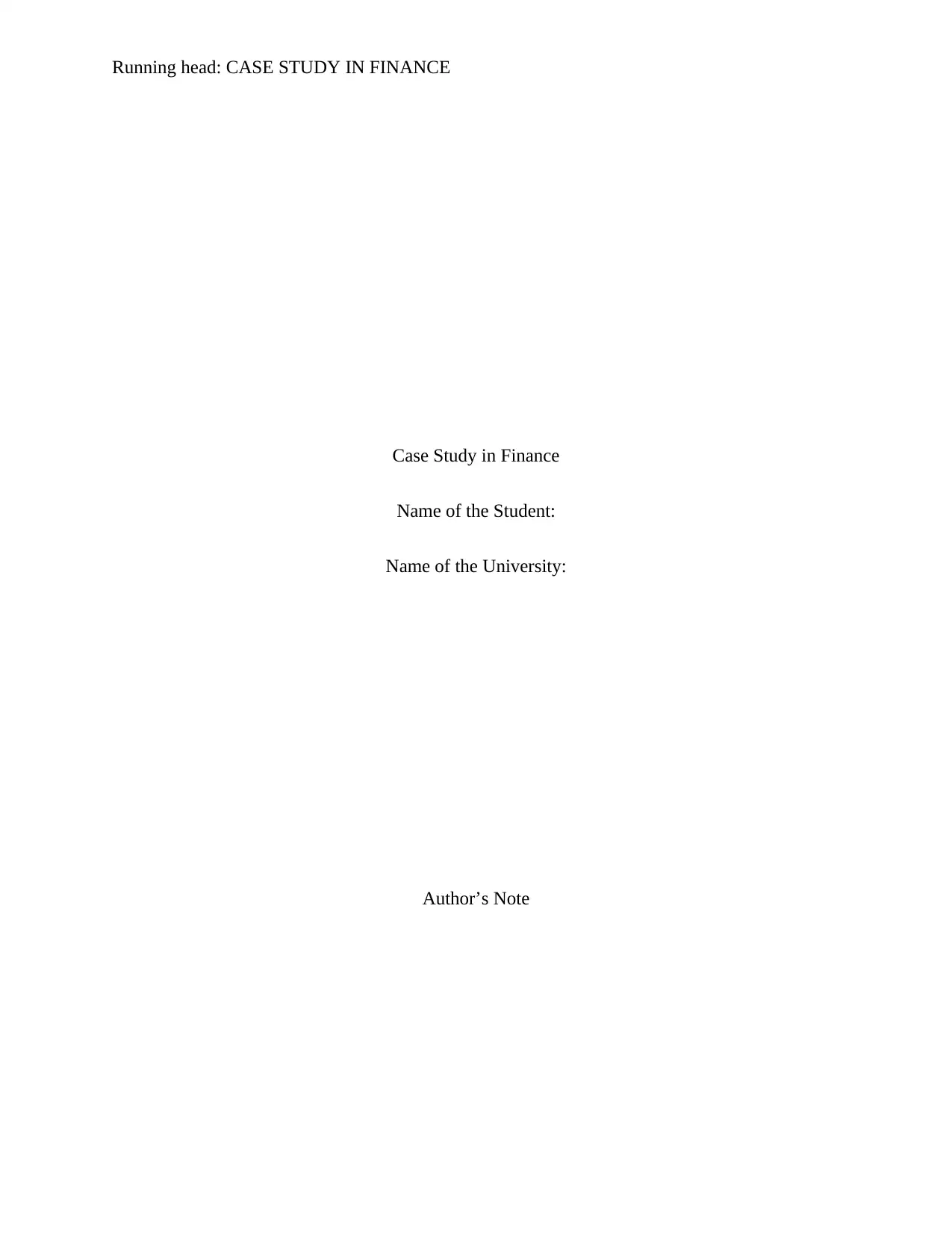
Running head: CASE STUDY IN FINANCE
Case Study in Finance
Name of the Student:
Name of the University:
Author’s Note
Case Study in Finance
Name of the Student:
Name of the University:
Author’s Note
Paraphrase This Document
Need a fresh take? Get an instant paraphrase of this document with our AI Paraphraser
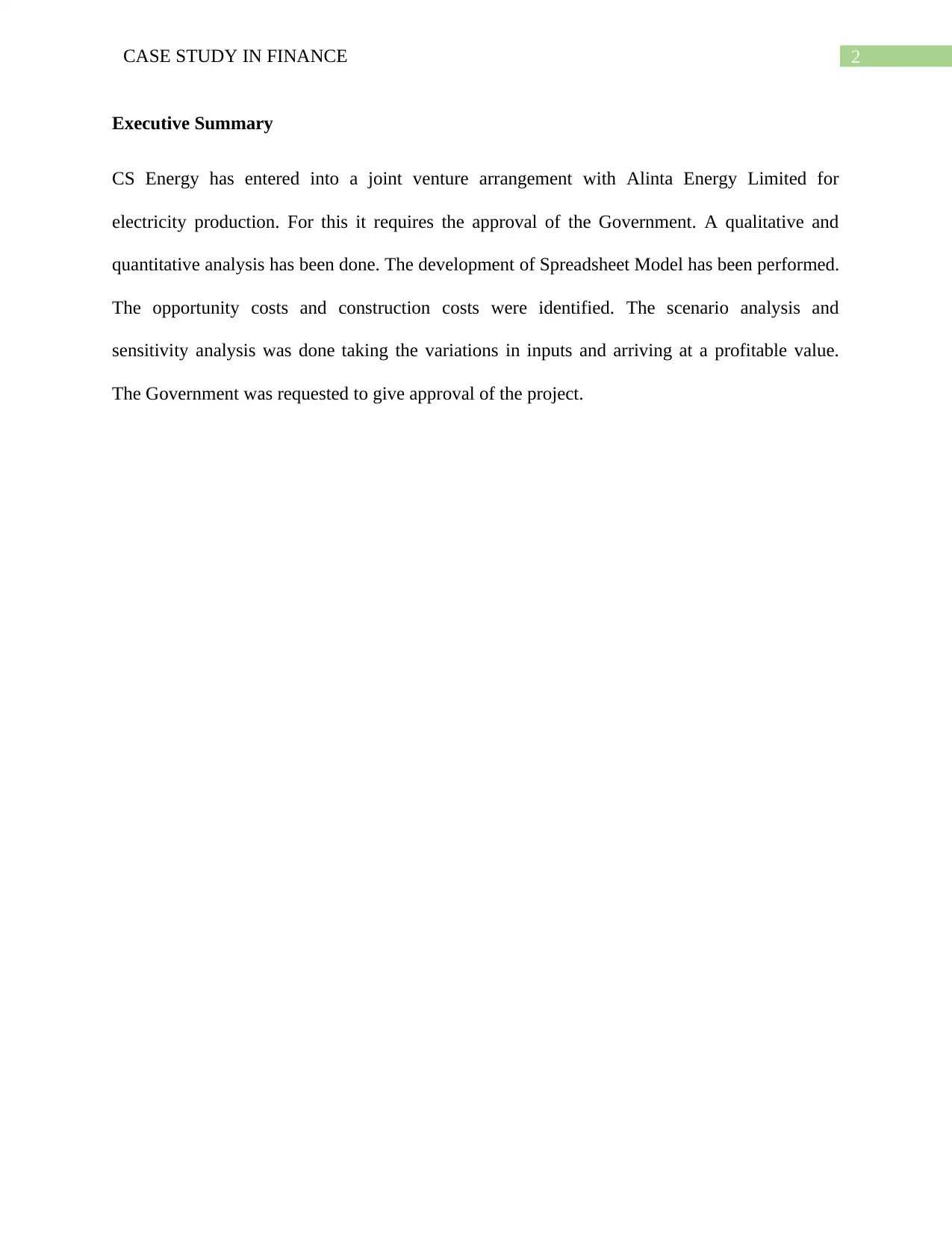
2CASE STUDY IN FINANCE
Executive Summary
CS Energy has entered into a joint venture arrangement with Alinta Energy Limited for
electricity production. For this it requires the approval of the Government. A qualitative and
quantitative analysis has been done. The development of Spreadsheet Model has been performed.
The opportunity costs and construction costs were identified. The scenario analysis and
sensitivity analysis was done taking the variations in inputs and arriving at a profitable value.
The Government was requested to give approval of the project.
Executive Summary
CS Energy has entered into a joint venture arrangement with Alinta Energy Limited for
electricity production. For this it requires the approval of the Government. A qualitative and
quantitative analysis has been done. The development of Spreadsheet Model has been performed.
The opportunity costs and construction costs were identified. The scenario analysis and
sensitivity analysis was done taking the variations in inputs and arriving at a profitable value.
The Government was requested to give approval of the project.
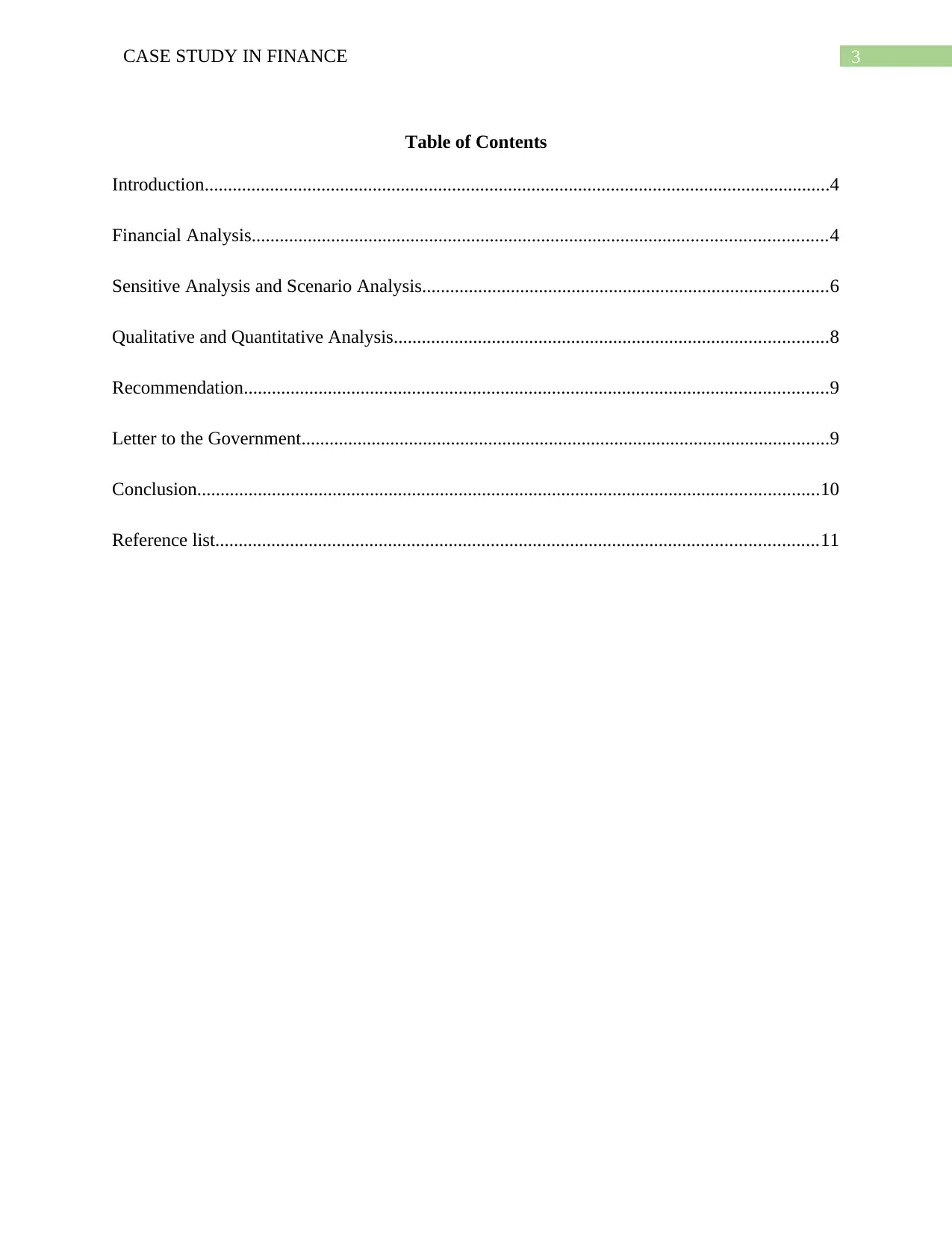
3CASE STUDY IN FINANCE
Table of Contents
Introduction......................................................................................................................................4
Financial Analysis...........................................................................................................................4
Sensitive Analysis and Scenario Analysis.......................................................................................6
Qualitative and Quantitative Analysis.............................................................................................8
Recommendation.............................................................................................................................9
Letter to the Government.................................................................................................................9
Conclusion.....................................................................................................................................10
Reference list.................................................................................................................................11
Table of Contents
Introduction......................................................................................................................................4
Financial Analysis...........................................................................................................................4
Sensitive Analysis and Scenario Analysis.......................................................................................6
Qualitative and Quantitative Analysis.............................................................................................8
Recommendation.............................................................................................................................9
Letter to the Government.................................................................................................................9
Conclusion.....................................................................................................................................10
Reference list.................................................................................................................................11
⊘ This is a preview!⊘
Do you want full access?
Subscribe today to unlock all pages.

Trusted by 1+ million students worldwide
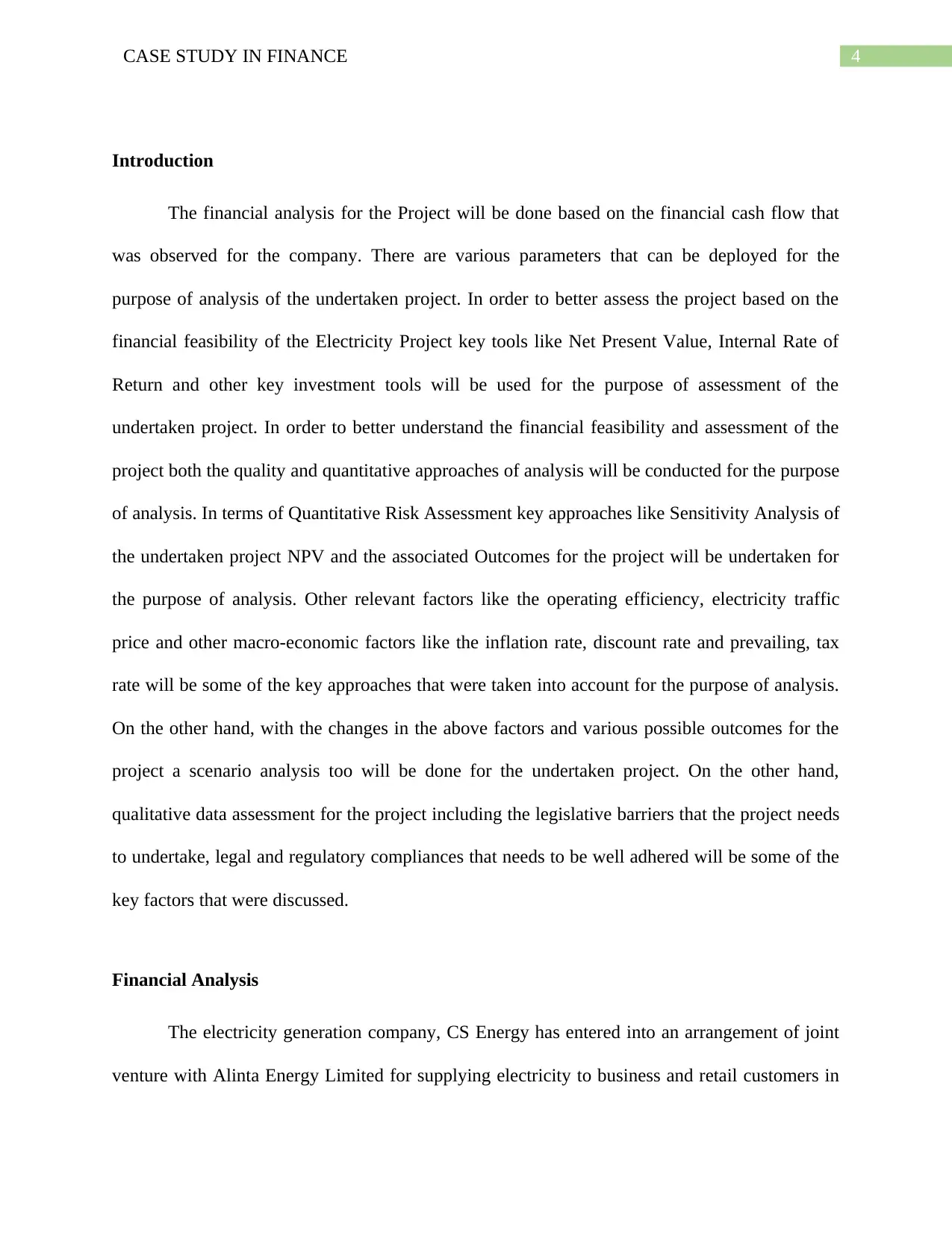
4CASE STUDY IN FINANCE
Introduction
The financial analysis for the Project will be done based on the financial cash flow that
was observed for the company. There are various parameters that can be deployed for the
purpose of analysis of the undertaken project. In order to better assess the project based on the
financial feasibility of the Electricity Project key tools like Net Present Value, Internal Rate of
Return and other key investment tools will be used for the purpose of assessment of the
undertaken project. In order to better understand the financial feasibility and assessment of the
project both the quality and quantitative approaches of analysis will be conducted for the purpose
of analysis. In terms of Quantitative Risk Assessment key approaches like Sensitivity Analysis of
the undertaken project NPV and the associated Outcomes for the project will be undertaken for
the purpose of analysis. Other relevant factors like the operating efficiency, electricity traffic
price and other macro-economic factors like the inflation rate, discount rate and prevailing, tax
rate will be some of the key approaches that were taken into account for the purpose of analysis.
On the other hand, with the changes in the above factors and various possible outcomes for the
project a scenario analysis too will be done for the undertaken project. On the other hand,
qualitative data assessment for the project including the legislative barriers that the project needs
to undertake, legal and regulatory compliances that needs to be well adhered will be some of the
key factors that were discussed.
Financial Analysis
The electricity generation company, CS Energy has entered into an arrangement of joint
venture with Alinta Energy Limited for supplying electricity to business and retail customers in
Introduction
The financial analysis for the Project will be done based on the financial cash flow that
was observed for the company. There are various parameters that can be deployed for the
purpose of analysis of the undertaken project. In order to better assess the project based on the
financial feasibility of the Electricity Project key tools like Net Present Value, Internal Rate of
Return and other key investment tools will be used for the purpose of assessment of the
undertaken project. In order to better understand the financial feasibility and assessment of the
project both the quality and quantitative approaches of analysis will be conducted for the purpose
of analysis. In terms of Quantitative Risk Assessment key approaches like Sensitivity Analysis of
the undertaken project NPV and the associated Outcomes for the project will be undertaken for
the purpose of analysis. Other relevant factors like the operating efficiency, electricity traffic
price and other macro-economic factors like the inflation rate, discount rate and prevailing, tax
rate will be some of the key approaches that were taken into account for the purpose of analysis.
On the other hand, with the changes in the above factors and various possible outcomes for the
project a scenario analysis too will be done for the undertaken project. On the other hand,
qualitative data assessment for the project including the legislative barriers that the project needs
to undertake, legal and regulatory compliances that needs to be well adhered will be some of the
key factors that were discussed.
Financial Analysis
The electricity generation company, CS Energy has entered into an arrangement of joint
venture with Alinta Energy Limited for supplying electricity to business and retail customers in
Paraphrase This Document
Need a fresh take? Get an instant paraphrase of this document with our AI Paraphraser
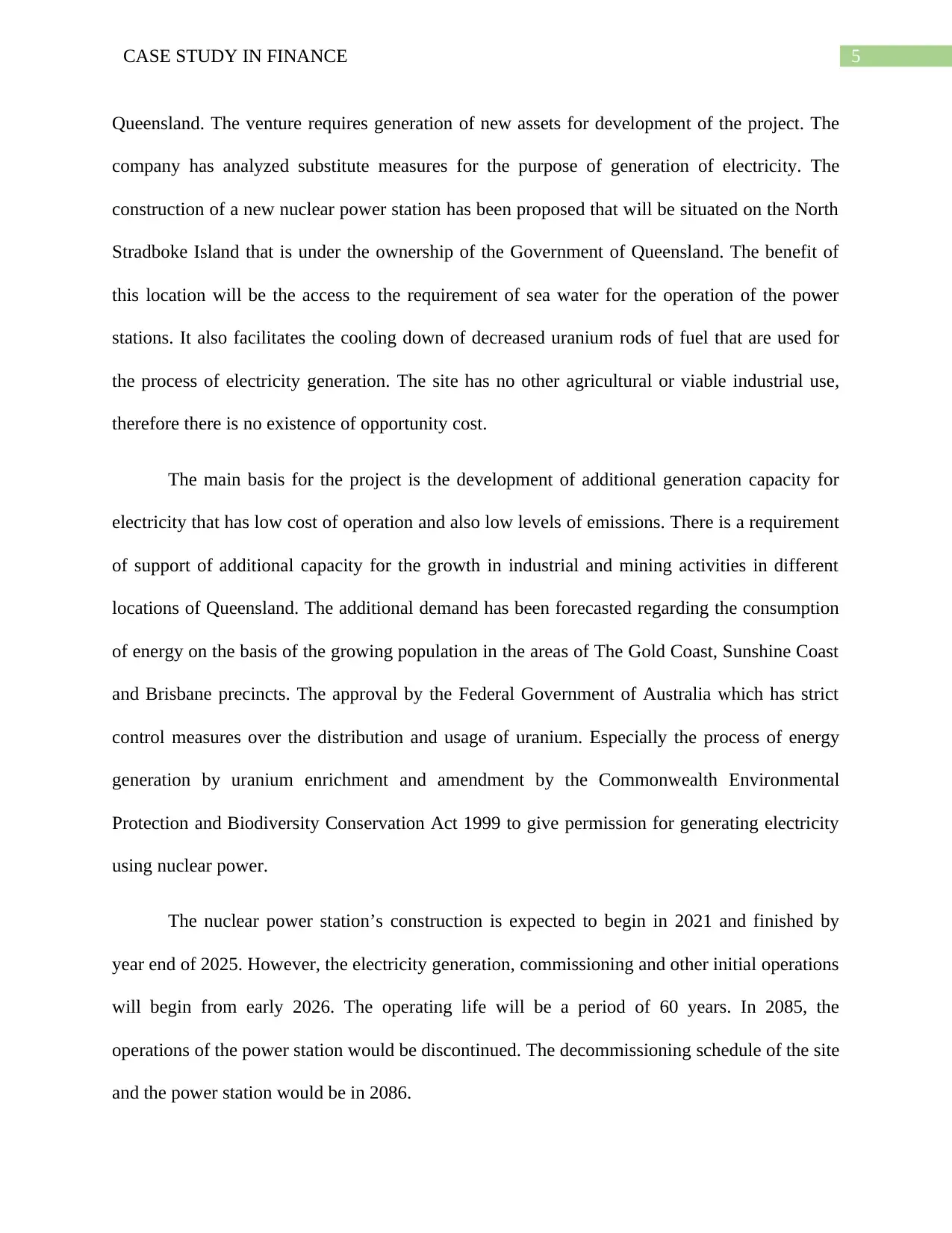
5CASE STUDY IN FINANCE
Queensland. The venture requires generation of new assets for development of the project. The
company has analyzed substitute measures for the purpose of generation of electricity. The
construction of a new nuclear power station has been proposed that will be situated on the North
Stradboke Island that is under the ownership of the Government of Queensland. The benefit of
this location will be the access to the requirement of sea water for the operation of the power
stations. It also facilitates the cooling down of decreased uranium rods of fuel that are used for
the process of electricity generation. The site has no other agricultural or viable industrial use,
therefore there is no existence of opportunity cost.
The main basis for the project is the development of additional generation capacity for
electricity that has low cost of operation and also low levels of emissions. There is a requirement
of support of additional capacity for the growth in industrial and mining activities in different
locations of Queensland. The additional demand has been forecasted regarding the consumption
of energy on the basis of the growing population in the areas of The Gold Coast, Sunshine Coast
and Brisbane precincts. The approval by the Federal Government of Australia which has strict
control measures over the distribution and usage of uranium. Especially the process of energy
generation by uranium enrichment and amendment by the Commonwealth Environmental
Protection and Biodiversity Conservation Act 1999 to give permission for generating electricity
using nuclear power.
The nuclear power station’s construction is expected to begin in 2021 and finished by
year end of 2025. However, the electricity generation, commissioning and other initial operations
will begin from early 2026. The operating life will be a period of 60 years. In 2085, the
operations of the power station would be discontinued. The decommissioning schedule of the site
and the power station would be in 2086.
Queensland. The venture requires generation of new assets for development of the project. The
company has analyzed substitute measures for the purpose of generation of electricity. The
construction of a new nuclear power station has been proposed that will be situated on the North
Stradboke Island that is under the ownership of the Government of Queensland. The benefit of
this location will be the access to the requirement of sea water for the operation of the power
stations. It also facilitates the cooling down of decreased uranium rods of fuel that are used for
the process of electricity generation. The site has no other agricultural or viable industrial use,
therefore there is no existence of opportunity cost.
The main basis for the project is the development of additional generation capacity for
electricity that has low cost of operation and also low levels of emissions. There is a requirement
of support of additional capacity for the growth in industrial and mining activities in different
locations of Queensland. The additional demand has been forecasted regarding the consumption
of energy on the basis of the growing population in the areas of The Gold Coast, Sunshine Coast
and Brisbane precincts. The approval by the Federal Government of Australia which has strict
control measures over the distribution and usage of uranium. Especially the process of energy
generation by uranium enrichment and amendment by the Commonwealth Environmental
Protection and Biodiversity Conservation Act 1999 to give permission for generating electricity
using nuclear power.
The nuclear power station’s construction is expected to begin in 2021 and finished by
year end of 2025. However, the electricity generation, commissioning and other initial operations
will begin from early 2026. The operating life will be a period of 60 years. In 2085, the
operations of the power station would be discontinued. The decommissioning schedule of the site
and the power station would be in 2086.
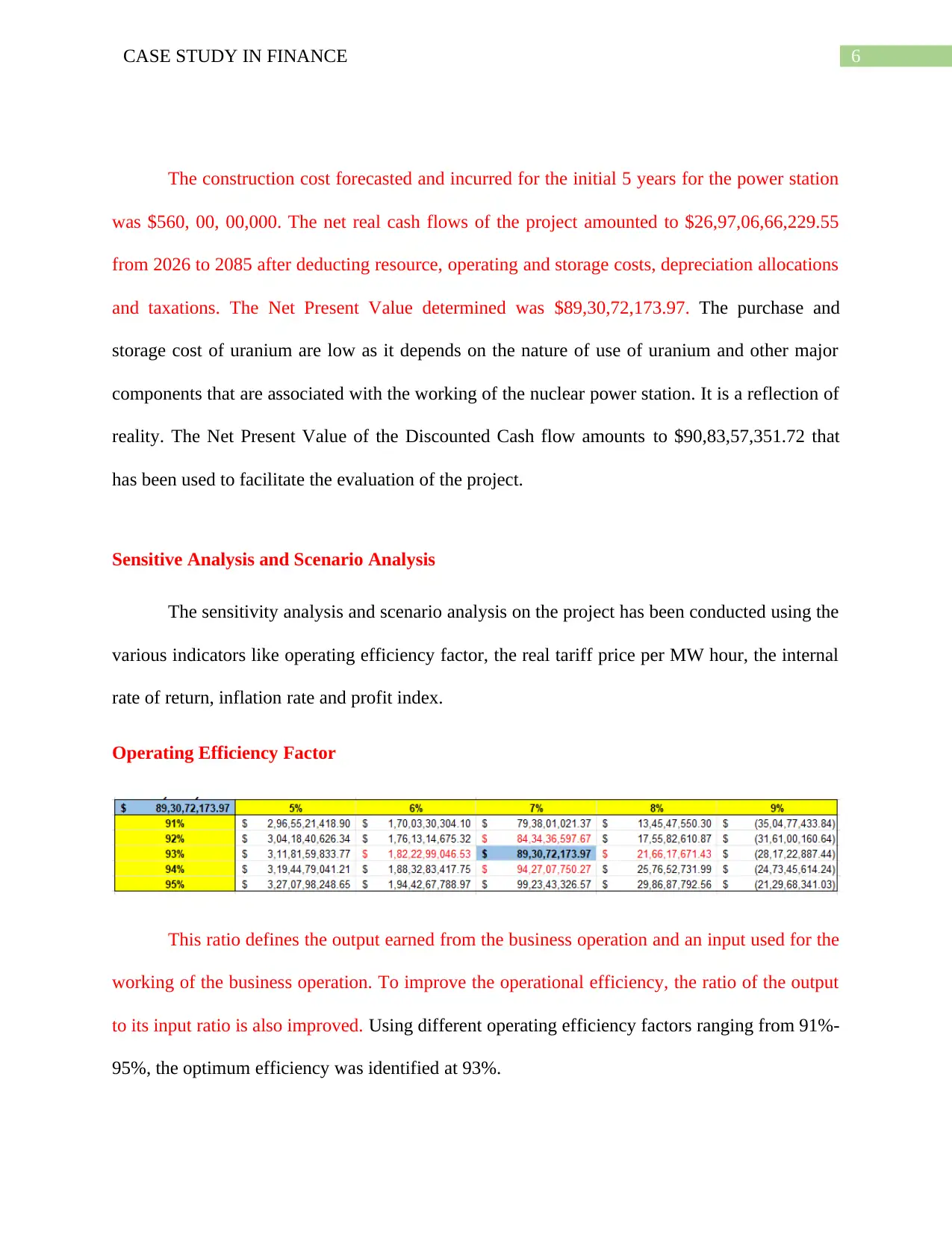
6CASE STUDY IN FINANCE
The construction cost forecasted and incurred for the initial 5 years for the power station
was $560, 00, 00,000. The net real cash flows of the project amounted to $26,97,06,66,229.55
from 2026 to 2085 after deducting resource, operating and storage costs, depreciation allocations
and taxations. The Net Present Value determined was $89,30,72,173.97. The purchase and
storage cost of uranium are low as it depends on the nature of use of uranium and other major
components that are associated with the working of the nuclear power station. It is a reflection of
reality. The Net Present Value of the Discounted Cash flow amounts to $90,83,57,351.72 that
has been used to facilitate the evaluation of the project.
Sensitive Analysis and Scenario Analysis
The sensitivity analysis and scenario analysis on the project has been conducted using the
various indicators like operating efficiency factor, the real tariff price per MW hour, the internal
rate of return, inflation rate and profit index.
Operating Efficiency Factor
This ratio defines the output earned from the business operation and an input used for the
working of the business operation. To improve the operational efficiency, the ratio of the output
to its input ratio is also improved. Using different operating efficiency factors ranging from 91%-
95%, the optimum efficiency was identified at 93%.
The construction cost forecasted and incurred for the initial 5 years for the power station
was $560, 00, 00,000. The net real cash flows of the project amounted to $26,97,06,66,229.55
from 2026 to 2085 after deducting resource, operating and storage costs, depreciation allocations
and taxations. The Net Present Value determined was $89,30,72,173.97. The purchase and
storage cost of uranium are low as it depends on the nature of use of uranium and other major
components that are associated with the working of the nuclear power station. It is a reflection of
reality. The Net Present Value of the Discounted Cash flow amounts to $90,83,57,351.72 that
has been used to facilitate the evaluation of the project.
Sensitive Analysis and Scenario Analysis
The sensitivity analysis and scenario analysis on the project has been conducted using the
various indicators like operating efficiency factor, the real tariff price per MW hour, the internal
rate of return, inflation rate and profit index.
Operating Efficiency Factor
This ratio defines the output earned from the business operation and an input used for the
working of the business operation. To improve the operational efficiency, the ratio of the output
to its input ratio is also improved. Using different operating efficiency factors ranging from 91%-
95%, the optimum efficiency was identified at 93%.
⊘ This is a preview!⊘
Do you want full access?
Subscribe today to unlock all pages.

Trusted by 1+ million students worldwide
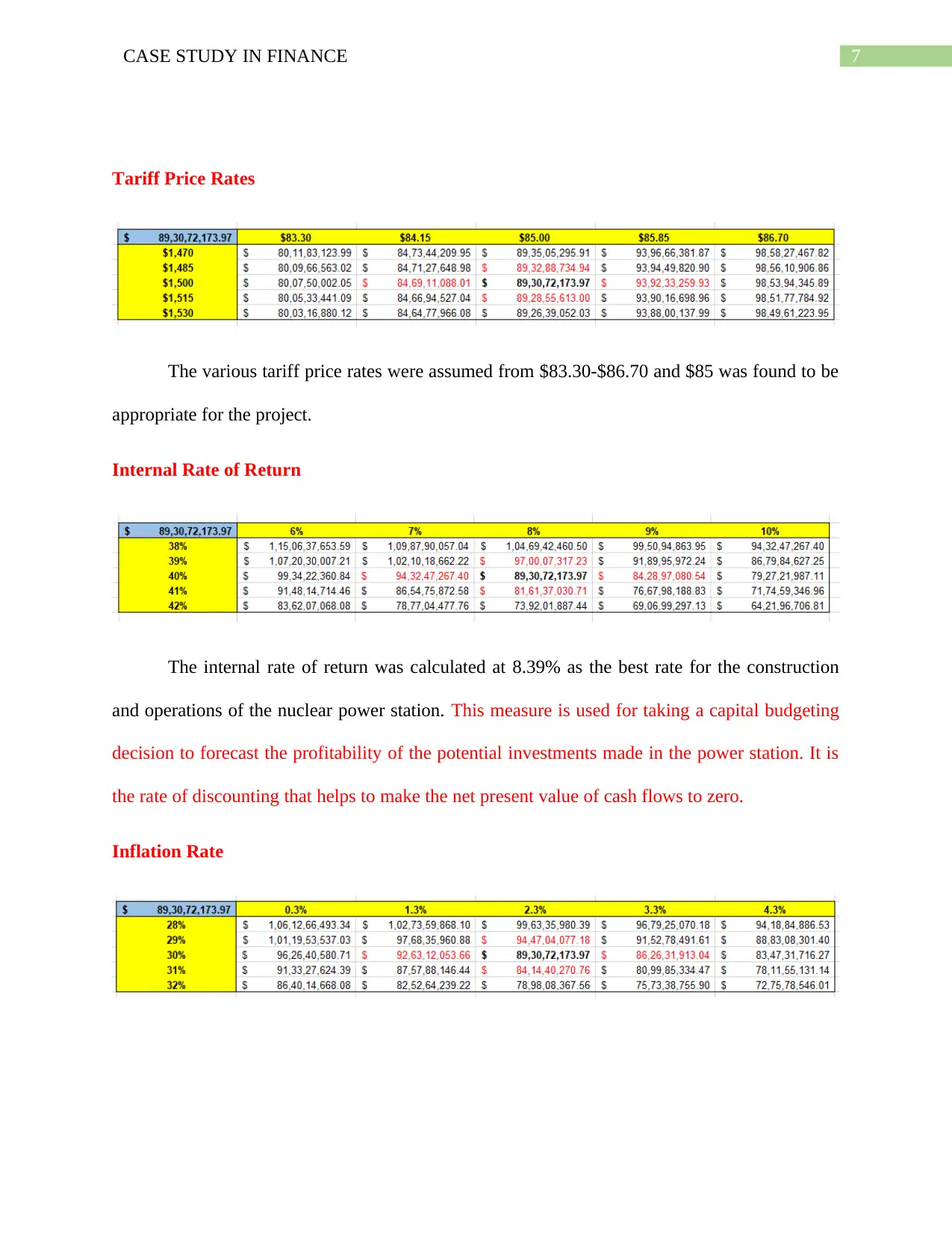
7CASE STUDY IN FINANCE
Tariff Price Rates
The various tariff price rates were assumed from $83.30-$86.70 and $85 was found to be
appropriate for the project.
Internal Rate of Return
The internal rate of return was calculated at 8.39% as the best rate for the construction
and operations of the nuclear power station. This measure is used for taking a capital budgeting
decision to forecast the profitability of the potential investments made in the power station. It is
the rate of discounting that helps to make the net present value of cash flows to zero.
Inflation Rate
Tariff Price Rates
The various tariff price rates were assumed from $83.30-$86.70 and $85 was found to be
appropriate for the project.
Internal Rate of Return
The internal rate of return was calculated at 8.39% as the best rate for the construction
and operations of the nuclear power station. This measure is used for taking a capital budgeting
decision to forecast the profitability of the potential investments made in the power station. It is
the rate of discounting that helps to make the net present value of cash flows to zero.
Inflation Rate
Paraphrase This Document
Need a fresh take? Get an instant paraphrase of this document with our AI Paraphraser
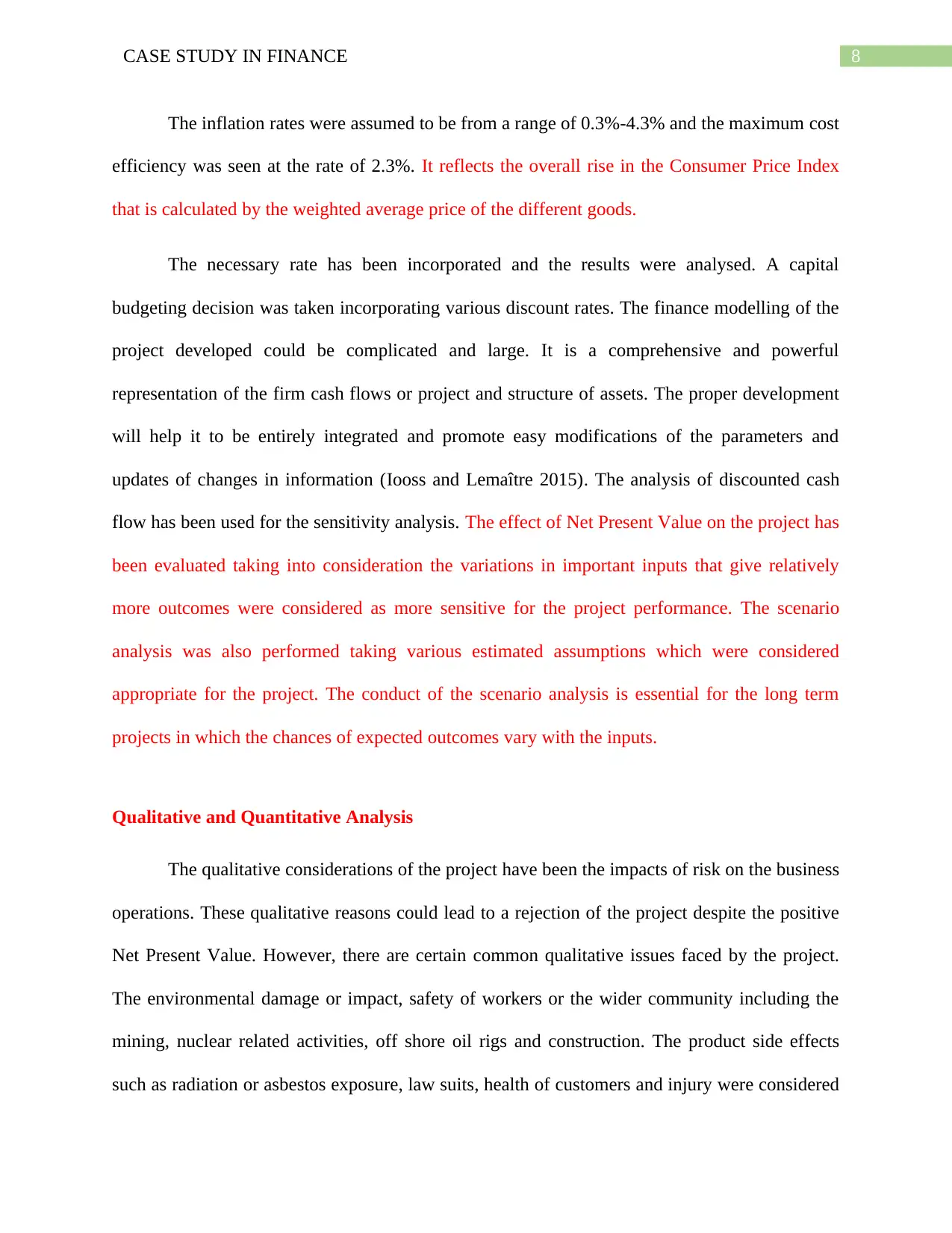
8CASE STUDY IN FINANCE
The inflation rates were assumed to be from a range of 0.3%-4.3% and the maximum cost
efficiency was seen at the rate of 2.3%. It reflects the overall rise in the Consumer Price Index
that is calculated by the weighted average price of the different goods.
The necessary rate has been incorporated and the results were analysed. A capital
budgeting decision was taken incorporating various discount rates. The finance modelling of the
project developed could be complicated and large. It is a comprehensive and powerful
representation of the firm cash flows or project and structure of assets. The proper development
will help it to be entirely integrated and promote easy modifications of the parameters and
updates of changes in information (Iooss and Lemaître 2015). The analysis of discounted cash
flow has been used for the sensitivity analysis. The effect of Net Present Value on the project has
been evaluated taking into consideration the variations in important inputs that give relatively
more outcomes were considered as more sensitive for the project performance. The scenario
analysis was also performed taking various estimated assumptions which were considered
appropriate for the project. The conduct of the scenario analysis is essential for the long term
projects in which the chances of expected outcomes vary with the inputs.
Qualitative and Quantitative Analysis
The qualitative considerations of the project have been the impacts of risk on the business
operations. These qualitative reasons could lead to a rejection of the project despite the positive
Net Present Value. However, there are certain common qualitative issues faced by the project.
The environmental damage or impact, safety of workers or the wider community including the
mining, nuclear related activities, off shore oil rigs and construction. The product side effects
such as radiation or asbestos exposure, law suits, health of customers and injury were considered
The inflation rates were assumed to be from a range of 0.3%-4.3% and the maximum cost
efficiency was seen at the rate of 2.3%. It reflects the overall rise in the Consumer Price Index
that is calculated by the weighted average price of the different goods.
The necessary rate has been incorporated and the results were analysed. A capital
budgeting decision was taken incorporating various discount rates. The finance modelling of the
project developed could be complicated and large. It is a comprehensive and powerful
representation of the firm cash flows or project and structure of assets. The proper development
will help it to be entirely integrated and promote easy modifications of the parameters and
updates of changes in information (Iooss and Lemaître 2015). The analysis of discounted cash
flow has been used for the sensitivity analysis. The effect of Net Present Value on the project has
been evaluated taking into consideration the variations in important inputs that give relatively
more outcomes were considered as more sensitive for the project performance. The scenario
analysis was also performed taking various estimated assumptions which were considered
appropriate for the project. The conduct of the scenario analysis is essential for the long term
projects in which the chances of expected outcomes vary with the inputs.
Qualitative and Quantitative Analysis
The qualitative considerations of the project have been the impacts of risk on the business
operations. These qualitative reasons could lead to a rejection of the project despite the positive
Net Present Value. However, there are certain common qualitative issues faced by the project.
The environmental damage or impact, safety of workers or the wider community including the
mining, nuclear related activities, off shore oil rigs and construction. The product side effects
such as radiation or asbestos exposure, law suits, health of customers and injury were considered
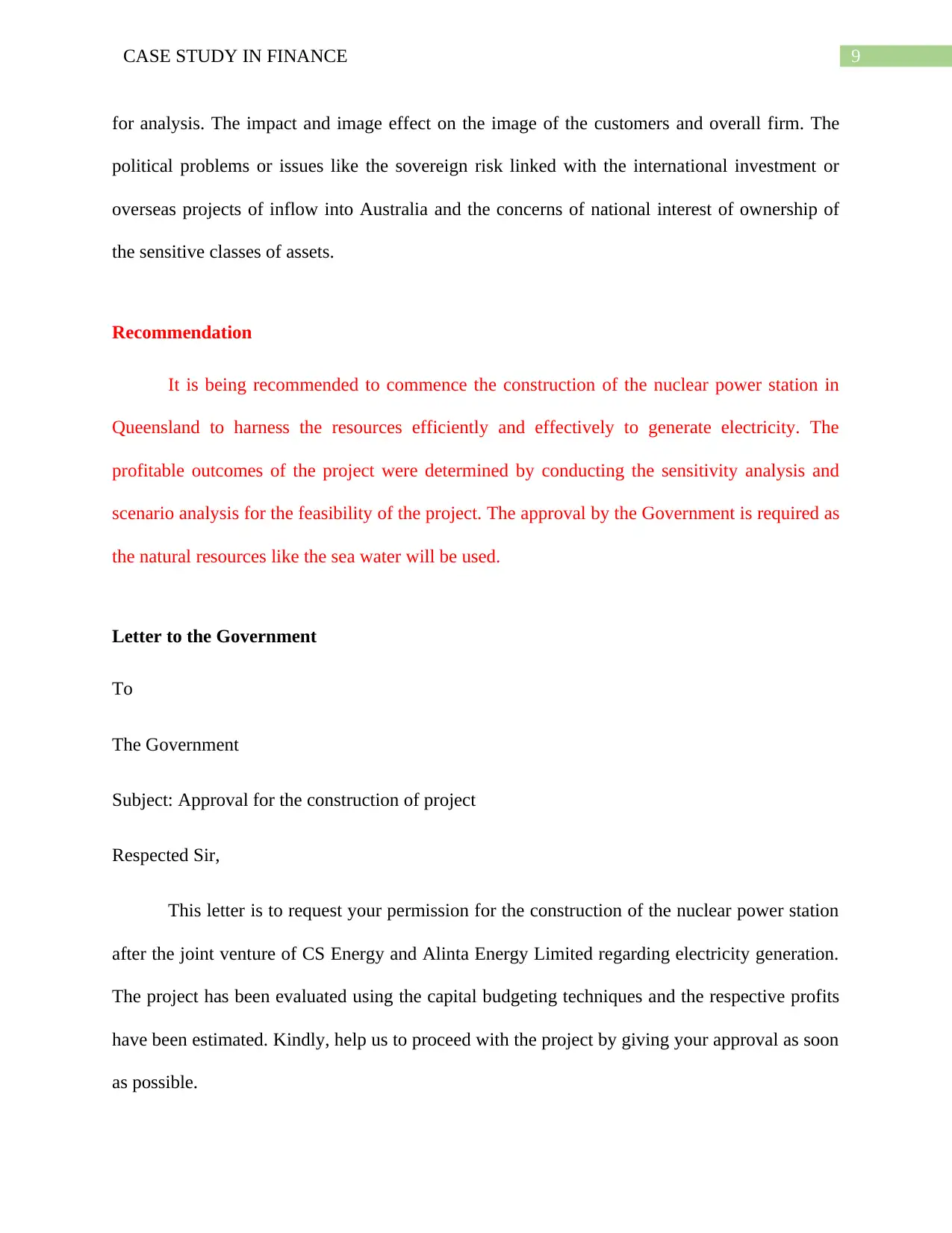
9CASE STUDY IN FINANCE
for analysis. The impact and image effect on the image of the customers and overall firm. The
political problems or issues like the sovereign risk linked with the international investment or
overseas projects of inflow into Australia and the concerns of national interest of ownership of
the sensitive classes of assets.
Recommendation
It is being recommended to commence the construction of the nuclear power station in
Queensland to harness the resources efficiently and effectively to generate electricity. The
profitable outcomes of the project were determined by conducting the sensitivity analysis and
scenario analysis for the feasibility of the project. The approval by the Government is required as
the natural resources like the sea water will be used.
Letter to the Government
To
The Government
Subject: Approval for the construction of project
Respected Sir,
This letter is to request your permission for the construction of the nuclear power station
after the joint venture of CS Energy and Alinta Energy Limited regarding electricity generation.
The project has been evaluated using the capital budgeting techniques and the respective profits
have been estimated. Kindly, help us to proceed with the project by giving your approval as soon
as possible.
for analysis. The impact and image effect on the image of the customers and overall firm. The
political problems or issues like the sovereign risk linked with the international investment or
overseas projects of inflow into Australia and the concerns of national interest of ownership of
the sensitive classes of assets.
Recommendation
It is being recommended to commence the construction of the nuclear power station in
Queensland to harness the resources efficiently and effectively to generate electricity. The
profitable outcomes of the project were determined by conducting the sensitivity analysis and
scenario analysis for the feasibility of the project. The approval by the Government is required as
the natural resources like the sea water will be used.
Letter to the Government
To
The Government
Subject: Approval for the construction of project
Respected Sir,
This letter is to request your permission for the construction of the nuclear power station
after the joint venture of CS Energy and Alinta Energy Limited regarding electricity generation.
The project has been evaluated using the capital budgeting techniques and the respective profits
have been estimated. Kindly, help us to proceed with the project by giving your approval as soon
as possible.
⊘ This is a preview!⊘
Do you want full access?
Subscribe today to unlock all pages.

Trusted by 1+ million students worldwide
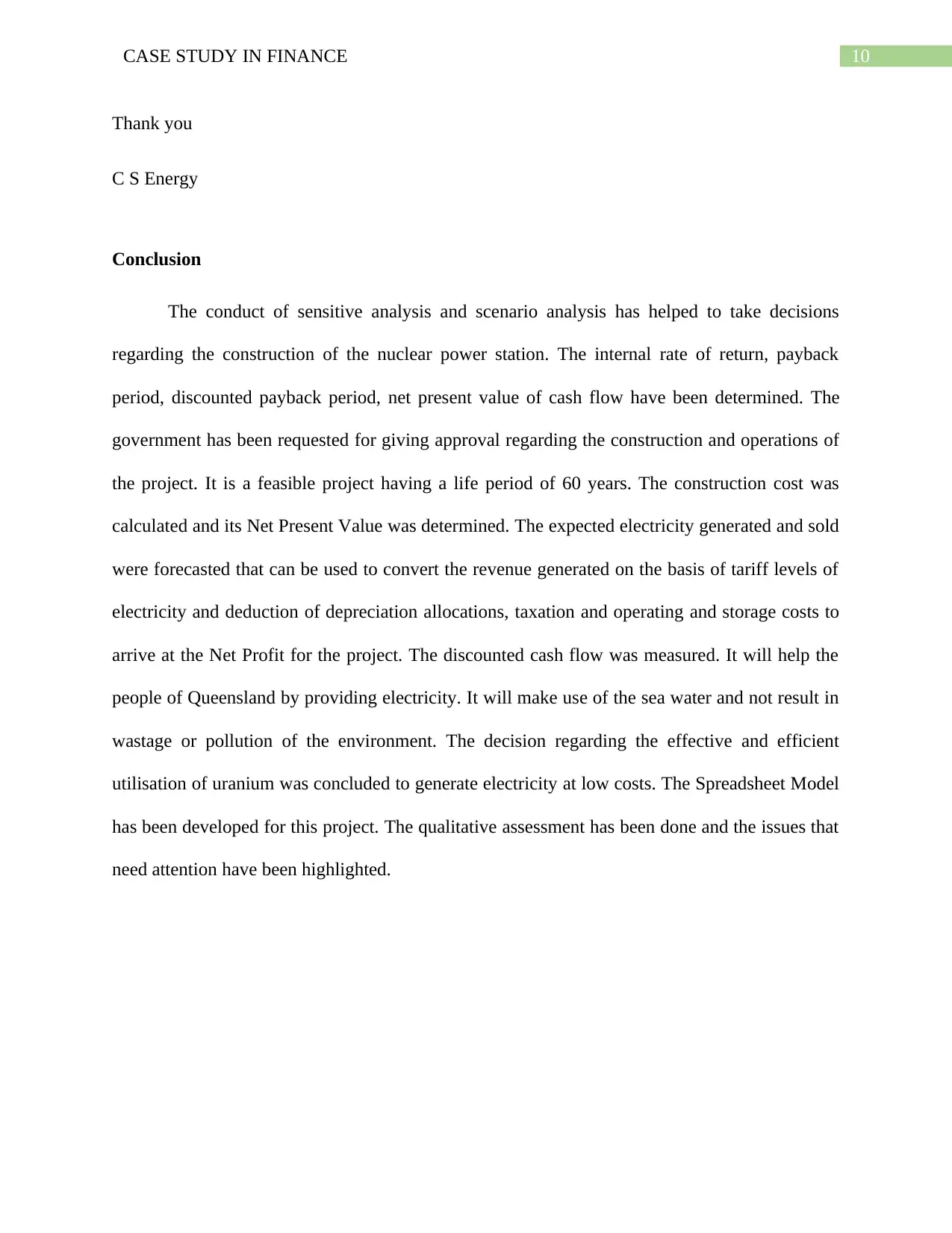
10CASE STUDY IN FINANCE
Thank you
C S Energy
Conclusion
The conduct of sensitive analysis and scenario analysis has helped to take decisions
regarding the construction of the nuclear power station. The internal rate of return, payback
period, discounted payback period, net present value of cash flow have been determined. The
government has been requested for giving approval regarding the construction and operations of
the project. It is a feasible project having a life period of 60 years. The construction cost was
calculated and its Net Present Value was determined. The expected electricity generated and sold
were forecasted that can be used to convert the revenue generated on the basis of tariff levels of
electricity and deduction of depreciation allocations, taxation and operating and storage costs to
arrive at the Net Profit for the project. The discounted cash flow was measured. It will help the
people of Queensland by providing electricity. It will make use of the sea water and not result in
wastage or pollution of the environment. The decision regarding the effective and efficient
utilisation of uranium was concluded to generate electricity at low costs. The Spreadsheet Model
has been developed for this project. The qualitative assessment has been done and the issues that
need attention have been highlighted.
Thank you
C S Energy
Conclusion
The conduct of sensitive analysis and scenario analysis has helped to take decisions
regarding the construction of the nuclear power station. The internal rate of return, payback
period, discounted payback period, net present value of cash flow have been determined. The
government has been requested for giving approval regarding the construction and operations of
the project. It is a feasible project having a life period of 60 years. The construction cost was
calculated and its Net Present Value was determined. The expected electricity generated and sold
were forecasted that can be used to convert the revenue generated on the basis of tariff levels of
electricity and deduction of depreciation allocations, taxation and operating and storage costs to
arrive at the Net Profit for the project. The discounted cash flow was measured. It will help the
people of Queensland by providing electricity. It will make use of the sea water and not result in
wastage or pollution of the environment. The decision regarding the effective and efficient
utilisation of uranium was concluded to generate electricity at low costs. The Spreadsheet Model
has been developed for this project. The qualitative assessment has been done and the issues that
need attention have been highlighted.
Paraphrase This Document
Need a fresh take? Get an instant paraphrase of this document with our AI Paraphraser

11CASE STUDY IN FINANCE
Reference list
Iooss, B. and Lemaître, P., 2015. A review on global sensitivity analysis methods.
In Uncertainty management in simulation-optimization of complex systems (pp. 101-122).
Springer, Boston, MA.
Reference list
Iooss, B. and Lemaître, P., 2015. A review on global sensitivity analysis methods.
In Uncertainty management in simulation-optimization of complex systems (pp. 101-122).
Springer, Boston, MA.
1 out of 11
Related Documents
Your All-in-One AI-Powered Toolkit for Academic Success.
+13062052269
info@desklib.com
Available 24*7 on WhatsApp / Email
![[object Object]](/_next/static/media/star-bottom.7253800d.svg)
Unlock your academic potential
Copyright © 2020–2025 A2Z Services. All Rights Reserved. Developed and managed by ZUCOL.





